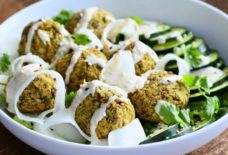Mediterranean Cooking from the Garden with Linda Dalal Sawaya—the season of pomegranate begins!
festive baba ghannouj with pomegranate and mint garnish © linda dalal sawaya 2015
In the Northern Hemisphere, we are deep into the fall season, harvest time, and soon the holidays. What more lovely way to celebrate this colorful season than with rimman—pomegranates!
pomegranate © linda dalal sawaya 2015
Originating in the area of Iran or ancient Persia, this fruit has been cultivated for millennia from the Middle East to India and has been revered in culinary as well as fine arts. Large dried pomegranate fruits were found in Egyptian tombs. The gorgeous red color of the traditional granada and its clusters of ruby-jewel, juicy seeds entice many of our senses. Its flavor is sweet, sour, and umami simultaneously and becomes a unique addition to our culinary creations. Its uses as a fruit, which is technically considered a berry, are traditional—eaten raw just as they are succulently exposed; and they make an exquisite garnish.
fruit mandala with pomegranate garnish © linda dalal sawaya 2015
The fruit has become so popular that there are videos circulating online on the easiest way to extract the seeds from under water to a very practical way of cutting the fruit by a Mediterranean man; and gee, it’s much better than the underwater or smacking method and is worth watching the video for the explanation!
The fresh juice of this fruit is heavenly as I first tasted it on the streets of Damascus back in 1996 from a vendor with yellowish red rimman piled high on a cart with his juice press at the ready. Surprisingly the juice was super sweet even though not deep red.
Today, pomegranate juice has become known as a “superfood” because of its high antioxidant properties and is readily available bottled and ready to drink. Of course the bottled version is nothing like the fresh pressed juice, yet it is wonderfully accessible and nutritious. The liqueur called grenadine famous in many cocktails is derived from granada fruit.
In Lebanon and other countries of the Middle East, the way of preserving this abundant fruit is to create a “molasses” with the juice of the fruit. It is cooked down for hours and becomes a thickly concentrated, deep red brown syrup called dibbis rimman. On one of my trips to Lebanon, I was blessed to taste this as well as dibbis made from grapes called dibbis ‘inab. Now if you’re not able to make your own dibbis, it is available in Middle Eastern groceries in glass bottles. I have not tried to make this yet—and it does sound easy—because my dear friend, Rima, somehow managed to bring me a huge homemade bottle from Lebanon—what a gift! Maybe when I use it all up, I’ll try making some.
commercial and homemade pomegranate molasses © linda dalal sawaya 2015
This same friend, Rima, from Trablos (Tripoli) in northern Lebanon, grew up eating dibbis rimman in fattoush, basted onto eggplants that are broiled, in fatteh, and no doubt in many other dishes. My family up in the mountains used primarily lemon juice for tartness rather than rimman, although the fruit is plentiful in my family village of Douma. No doubt some families use this, but it didn’t arrive in America with my mother back in the 1920s.
basting eggplant batinjan with dibbis rimman © linda dalal sawaya 2015
broiled eggplant with my homegrown yellow pomegranate seeds © linda dalal sawaya 2015
broiled eggplant with tart homegrown yellow pomegranate seeds garnish © linda dalal sawaya 2015
A tablespoon or two of dibbis rimman provide just enough umami, sweetness, and sourness to the roasted red pepper and walnut dip, mhammara. Without this ingredient, something would be missing; it would be flat and unexciting.
mhammara made with dibbis rimman © linda dalal sawaya 2015
While visiting Lebanon last fall, a dear new friend, Hayat, prepared a meal after our hike through the Tannourine cedar forest which included a Turkish dish called kisir, made with burghul (bulgar), parsley, tomatoes, onions, olive oil, and dibbis rimman. I just found out that this is the name of she made and it was delicious!
hayat’s delicious kisir © linda dalal sawaya 2015
A few years ago I planted an ornamental variety of pomegranate that has lovely yellow blossoms and a yellow fruit! If only I had planted a red one, but the yellow shrub is producing amazing fruit for me, which I’ve used to garnish baba ghannouj, and roasted eggplant.
yellow pomegranate blossom © linda dalal sawaya 2015
fall pomegranate bursting open on the branch © linda dalal sawaya 2015
hake-botan ornamental variety of pomegranate from my tree © linda dalal sawaya 2015
The variety is hake-botan and is quite lovely with tart light yellow fruit seeds. If I only had known it would actually provide fruit that would burst open while on the tree! I may just go and find a red pomegranate that might do well in the Pacific Northwest! But luckily, this formerly rare fruit is now available in most supermarkets during the season.
Douma village pomegranates in my cousin’s garden bursting open © linda dalal sawaya 2015
I hope you enjoy this amazing gift of nature in the upcoming months in many ways as you can! Sahtein!
—Linda Dalal Sawaya is a Portland artist, cook, Master Gardener, daughter of Lebanese immigrants, and author of Alice’s Kitchen: Traditional Lebanese Cooking
Remember, as my mother Alice said, “If you make it with love, it will be delicious!”
story and all photos © linda dalal sawaya 2015


